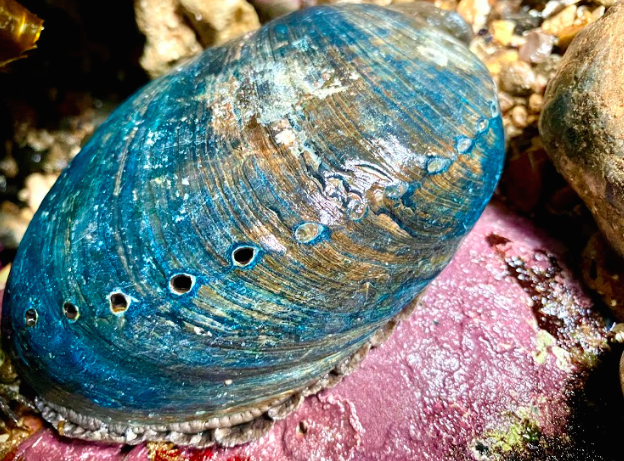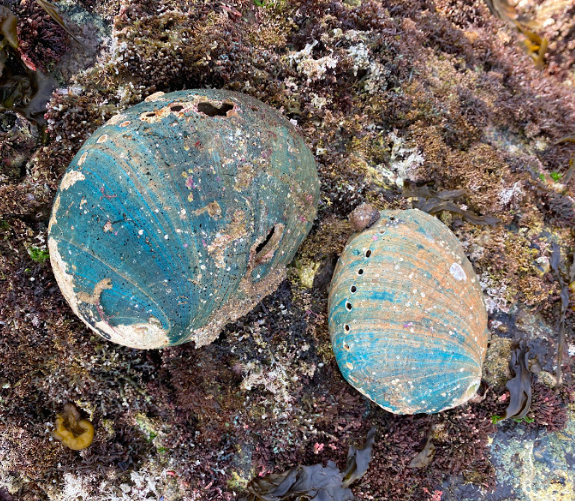Student Blog: Carmen Gardner
Black Abalone’s Comeback
Most know that southern California has a variety of gorgeous beaches: sandy, rocky, sunny, foggy, crowded, or secluded. What you may not know as you’re enjoying the coastal views from the sand is that what’s below the ocean’s surface is even more extraordinary. How do you get there without swimming or diving, you may ask? Low tide. As the moon pulls the water away from Earth, the rocky intertidal zone appears with life nestled in every crack and crevice. As a diver, I’m fortunate to have seen the beauty of marine life as it simply hangs out in its habitat, but there is also something about gently climbing over the rocks to explore the tide pools that is so engaging. When I lived in northern California, I enjoyed sunny days out on the beach, walking the rocky shorelines and searching for cool marine life. My capstone project is a never-ending scavenger hunt, searching for black abalone and the things that benefit or hold them back from establishing once again in Orange County (O.C). I didn’t know what black abalone looked like until I started the MCRS program, so I never looked for them when tidepool adventuring in the past. It’s a marine gastropod—kind of like a giant, beautiful snail of the ocean. I was thrilled to learn I was on the team that would have the opportunity to spend data collection in tidepools, but little did I know last year’s team hadn’t found a single black abalone. That was a little bit discouraging.
Black abalone (Haliotis cracherodii) live in cracks and crevices underneath and between boulders of the intertidal zone. They settle in ocean waters up to 20 ft deep (Raimondi et al. 2012). Their shell is blue, sometimes green, or black, and oval and smoother than any of the other abalone species. To eat algae such as giant kelp or feather boa kelp, they raise themselves off their rock and trap pieces under their muscular foot (NOAA, 2020). For thousands of years, native people along California’s coast ate abalone. They were traded along routes in southern California all the way to east of the Mississippi River (NOAA, 2020). Black abalone were important to commercial and recreational fishing in California since the mid-1800s and eventually their decline led to the collapse of black abalone commercial fishing (NMFS, 2019). They were listed on ESA as endangered in 2009 due to overfishing, withering syndrome disease, low densities, and low reproductive rates (NMFS, 2019). Their drastic population decline from withering syndrome disease made it difficult for their species to recover on its own. The disease quite literally withers away their muscular foot, with which is used to grab food and protect itself from predation (Crosson et al, 2014). Black abalone are considered locally extinct, but there is still potential to discover one (hence the word ‘considered’). You can imagine why I have been so excited to work on this project to potentially see such a creature in real life.
Learning their history has brought me back to mine. I remember when I became interested in the ocean as a kid when I read Island of the Blue Dolphins by Scott O’Dell. To remind those who have read the book and to summarize for those who have not, it is the fictional story of a young American Indian Woman, Karana, who was stranded on San Nicolas Island, one of the eight Channel Islands off the coast of California (O’Dell, 2016). She had been raised to live in harmony with the other members of her community, as well as the creatures of the land and sea. The cultural significance of abalone as an important resource for food was referenced as a means for survival and culture. Looking back now, I never thought I would be playing a part in the history of the same culturally significant species I read about as a young girl. Similar to Karana, I am searching for abalone (but not gathering abalone, of course).
My grandpa, a retired naval officer who grew up in South San Francisco and had traveled the world once upon a time, learned of my project and told me, “oh there used to be abalone galore.” He continued, “back when I was a young kid, my father would take me and my brother at low tide with a pry bar and a measuring gauge to collect what we could under the license we had. However, I wouldn’t eat any as a kid, but tried an abalone sandwich once when I was stationed in San Diego and it was good.” I couldn’t help but think how times have changed. There have been so many instances now that I have heard the phrase, “there used to be so many” when referring to abalone decline. These once abundant snails of the sea were dwindling right in front of my eyes growing up and had been for some time before me. Again, I felt discouraged by their potential fate. However, today I am a lot more optimistic that my team’s work will lead the way for black abalone’s big future comeback and here is why:
It was a cold, stormy day, and we were all bundled up, ready to get down and dirty, searching through cracks and crevices for what seemed to be a mythical creature. We headed out of Orange County for a data collection training day that was mostly to picture a reference site for suitable abalone habitat. My team and I weren’t getting our hopes up to find any black abs, if at all, “maybe one,” we said. We were just excited to kick off the field work of the project we had planned for three months prior and would be working on for the next few months. Little did we know it was going to be one of the best days as an MCRS student. Dr. Amy Henry went about guiding us where to start looking, and we then split up to explore the rest of the shortly exposed crevices. Suddenly, Dr. Henry yelled out, “A BLACK AB OVER HERE.” We were all so far from one another, we didn’t exactly hear what she had said, but by the excitement we could see in her face and the way she yelled out, we knew what that meant. Trying not to slip on the dampened rocks, we made our way over as quickly as possible. We searched the area and found three more!

As the project progressed and we began data collection, we were excited to search for the right spots to have as black abalone future homes. Completely disregarding the potential to find a black abalone in O.C., we went about our project, ready to see what other creatures we could find. It was a sunny day and a great low tide when we discovered a green abalone (Hailotis fulgens) in the areas we were collecting data. We continued to search and found at least fifty green abalone. Excited to see that a species related to black abalone was so abundant and thriving in such a beautiful habitat, we knew this site would be perfect. We continued to look around when suddenly my teammate Michaela yelled out, “oh my gosh, look what I found.” It didn’t register to me that it might be a black abalone—we get excited about a lot of things we find. It wasn’t a living one, but it was a black abalone shell! Then two shells! Evidence and validation, we were doing good work.

After finding evidence of black abalone in Orange County and seeing such a small population outside of the county, my thoughts immediately went to the stories of when black abalone were so abundant. How can we get more people to care about the loss of this beautiful species? Perhaps a sense of nostalgia and belonging. During surveys, we’ve seen other majestic creatures out at low tide such as octopus, nudibranchs, anemones, urchins, sea hare, and sea stars, but there was something extraordinary about finding such a rare species and knowing that we were working to conserve it. My team and I probably won’t find a living black abalone in Orange County during our project, but we are optimistic for the future of black abalone’s return to O.C. Just wait and see.
References
Crosson, L. M., Wight, N., VanBlaricom, G. R., Kiryu, I., Moore, J. D., & Friedman, C. S. (2014). Abalone withering syndrome: Distribution, impacts, current diagnostic methods and new findings. Diseases of aquatic organisms, 108(3), 261-270.
Eckdahl, K. (2015). Endangered black abalone (Haliotis cracherodii) abundance and habitat availability in Southern California. Master’s Thesis, California State University, Fullerton.
National Oceanic and Atmospheric Administration. (2020). Black Abalone. https://www.fisheries.noaa.gov/species/black-abalone#overview
National Marine Fisheries Service (NMFS). 2019. Draft Recovery Plan for the black abalone (Haliotis cracherodii). National Marine Fisheries Service, West Coast Region, Protected Resource Division, Long Beach, CA 90802.
O’dell, S., & Schwebel, S. L. (2016). Island of the Blue Dolphins: The Complete Reader’s Edition. Univ of California Press.
Raimondi, P., Orr, D., Fletcher, N., Fedfield, M., Lohse, D., Miner, M., George, M., Gaddam, R., Engle, J., Lee, Steven, & Witaker, S. (2012). Haliotis cracherodii, on San Clemente Island.


